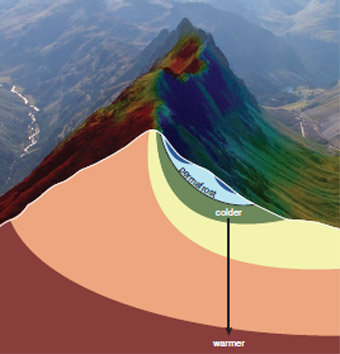Mountain Permafrost: At high elevations in mid-latitude mountains, permafrost is widespread where the mean annual air temperature is below –3°C. It often exists far below the altitudes, to which glaciers extend, and even below the tree line in continental areas. Mountain permafrost exists in different forms – in steep bedrock, in rock glaciers, in debris deposited by glaciers or in vegetated soil, and contains variable amounts of ice. Since topography causes large variability in local climate, snow cover, and ground and surface properties through the processes of erosion, transport and deposition, mean annual ground temperatures in mountain regions can vary by 5–8 °C over distances as small as 100 m (Figure 7.8).
For this reason, the distribution and characteristics of permafrost in mountain regions are very patchy. Permafrost influences the evolution of mountain landscapes and affects human infrastructure and safety. Permafrost warming or thaw affects the potential for natural hazards such as rock falls, debris flows and secondary events triggered by them and also affects the topography itself in steep terrain. As in Arctic permafrost regions, construction in mountain permafrost regions requires special precautions and warming permafrost poses problems to infrastructure. Mountain permafrost also contains valuable information on climate change. The presence of permafrost, in an actively moving rock glacier for example, indicates a relatively cold climate, therefore inactive or fossil rock glaciers point to past colder climates. Measurements of permafrost temperature, as well as providing information on present-day permafrost stability, offer data on past climate changes.

Figure 7.8: Temperatures in a mountain range containing permafrost (blue colours bordered by the black line), ranging from colder (blue) to warmer (red). Steep terrain and strong variability in surface temperatures are typical of mountain permafrost. The cross section in the foreground shows the complex distribution of subsurface temperatures characteristic of mountains, with the isotherms (lines linking points of equal temperature) nearly vertical in the ridge of the mountain. In the background, the colours on the mountain surface illustrate the strong variability in ground temperatures caused by differences in elevation, exposure to the sun, snow cover and ground properties. In the far background, one can only guess at this complex pattern of permafrost distribution because permafrost is invisible at the ground surface. Source: S. Gruber, photo from Christine Rothenbühler
Significant amounts of mountain permafrost exist in Svalbard, Fennoscandia, the Urals, the Caucasus, the Pyrenees, the Alps, and Iceland. Data from a north-south line of boreholes, 100 m or more deep, extending from Svalbard to the Alps show a long-term regional warming of permafrost of 0.5–1.0 °C during recent decades. In Scandinavia and Svalbard, monitoring over 5–7 years shows warming down to 60 m depth and present warming rates at the permafrost surface of 0.04–0.07° C/year. In Switzerland, a warming trend and increased active-layer depths were observed in 2003, but results varied strongly between borehole locations68. The warming signals from alpine boreholes are difficult to interpret due to the conflicting factors of topography and the heat released or absorbed during melting or evaporation. However, observations of European mountain permafrost degradation are consistent with climate trends and with the major changes in permafrost and ground ice conditions observed globally. These changes are expected to continue in the near future.
Human activity and permafrost affect each other, especially in the densely populated Alps. The speed of most monitored alpine rock glaciers, a form of mountain permafrost in which frozen debris and/or ice underlie a layer of debris and which move down slope, has increased significantly during recent years. This acceleration is likely due to a reduction in viscosity of the underlying permafrost as a result of warming. Warming of permafrost also affects infrastructure in alpine permafrost regions. An increase of instability problems has motivated the development of technical solutions to improve design lifetime, maintenance costs and safety. Warming can reduce the stability of permafrost in steep areas and thus cause increased rock falls. At least four large events involving rock volumes over 1 million m3 took place in the Alps during the last decade. In 2002, the Kolka Glacier rock and ice slide killed 125 people in the Karmadon Valley of the Caucasus, illustrating the potentially catastrophic consequences of such events.
The Central Asian region is the largest area of widespread mountain permafrost in the world. In Central Asia it occupies approximately 3.5 million square kilometres and makes up about 15 per cent of the total permafrost area in the Northern Hemisphere. The climatic variations during the 20th century and especially during the last two decades have impacted on current permafrost temperatures.
In the Tien Shan Mountains, Qinghai-Tibet Plateau, and western Mongolian sector of the Altai Mountains, observations over the last 30 years show that permafrost warmed by 0.3°C in undisturbed systems and by up to 0.6°C in areas affected by human activities (Figure 7.9). In the northern Tien Shan Mountains and the Mongolian Altai Mountains, the average active-layer thickness increased by 20–25 per cent in comparison with the early 1970s.
Material sourced from: United Nations Environment Programme (UNEP), 2007, Global Outlook for Ice and Snow, Glaciers and Ice Caps, http://www.unep.org/geo/geo_ice/
